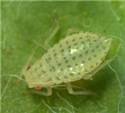Classification
Aphididae: Drepanosiphinae
Common name(s)
Yellow clover aphid
Diagnosis
Apterae distinctive, pale yellow, greenish white to almost white, rather shiny, with rows of dorsal light- or dark brown pigmented tubercles bearing capitate hairs. Alatae also have rows of pigmented tubercles on dorsum of abdomen, varying in extent and depth of pigmentation. Apterae and alatae both 1.4-2.2 mm. Antennae subequal to or nearly as long as body length. Processus terminalis almost equal to base of last antennal segment. Siphunculi smaller than knobbed cauda, 0.8x as long as cauda. Wing venetion normal with each vein slightly bordered and ending in pigmented tips.
The aphid co-occurs with Acyrthosiphon kondoi. Colonies of A. kondoi are found on terminal shoots, whereas T. trifolii is found on lower surface of lower leaves.
Distribution
Europe, the Mediterranean, North and South Africa, Middle East, USA, Australia, Japan, Pakistan, India (Allover south India except extreme south; Punjab, Haryana, Rajasthan, Delhi, Maharashtra).
Host plant(s)
Fabaceae: Medicago sativa Urban.
Measurements
Aptera: Length of body 1.78, width 0.97; antennae 1.72, segments III: IV: V: VI 0.57: 0.32: 0.33: (0.18+0.17); u.r.s. 0.09; h.t.2 0.11; siphunculus 0.08; cauda 0.10.
Alata: Length of body 2.2, width 0.85; antennae 1.90, segments III: IV: V: VI 0.08: 0.39: 0.38: (0.17+0.17); u.r.s. 0.09; h.t.2 0.10; siphunculus 0.09; cauda 0.11.
Seasonal occurrence
June-July and September-October.
Natural enemies
Coleoptera: Coccinellidae: Brumoides suturalis (F.), Cheilomenes sexmaculata (F.), Coccinella septempunctata L., C. transversalis F., Scymnus (Scymnus) nubilus Mulsant.
Diptera: Syrphidae: Paragus serratus (F.).
_sml.jpg)


_sml.jpg)
_sml.jpg)
_sml.jpg)
_sml.jpg)
_sml.jpg)
_sml.jpg)
_sml.jpg)
_sml.jpg)
_sml.jpg)

_sml.jpg)
_sml.jpg)

